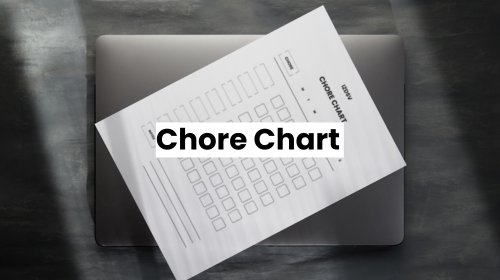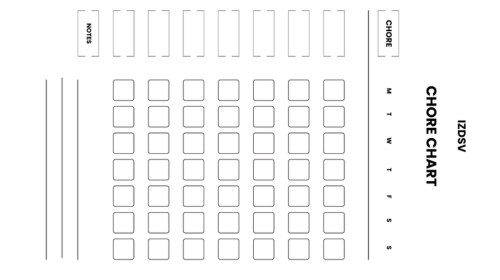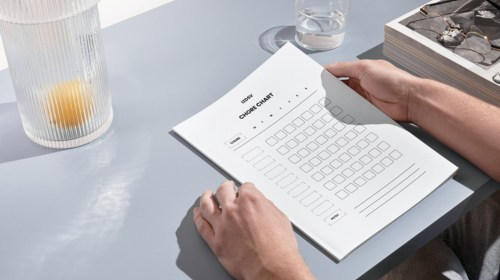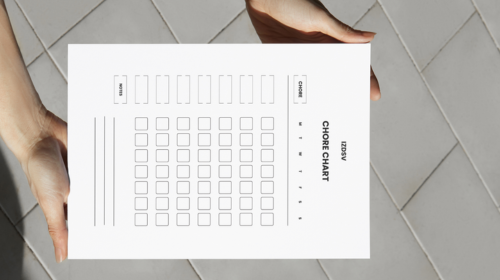Easy-to-Use Family Chore Chart Template
What is a Family Chore Chart?
A family chore chart is a visual organizational tool that assigns household tasks to different family members. It clearly displays who is responsible for specific chores and when those tasks need to be completed.
- A structured schedule showing household responsibilities for each family member
- Typically includes names, tasks, and timeframes (daily, weekly, monthly)
- Can be created digitally or physically (whiteboard, poster, printout)
- Often uses visual elements like checkboxes, stickers, or magnets to track completion
- Customizable based on family size, age, and household needs
Understanding the Concept of Chore Charts
Chore charts function as accountability systems that establish clear expectations for household maintenance among family members. They transform abstract responsibilities into concrete, visible tasks that can be tracked and acknowledged.
- Built on the principle of shared household responsibility
- Creates transparency about who does what and when
- Serves as both a reminder and a record-keeping system
- Can be adapted to different parenting and household management styles
- Helps establish routines and habits around household work
- Provides a visual reference point for family discussions about responsibilities
Benefits of Using a Family Chore Chart
Family chore charts promote accountability while helping to distribute household work more fairly among family members. They reduce the mental load typically carried by one parent by making responsibilities explicit and shared.
- Reduces arguments about who should do what tasks
- Decreases the need for repeated reminders about chores
- Creates a more equitable distribution of household labor
- Teaches responsibility and follow-through
- It gives all family members a sense of contribution to the household
- Reduces stress by eliminating uncertainty about expectations
- It helps maintain a cleaner, more organized home
- Can improve communication about household needs
How a Chore Chart Can Help Kids
Chore charts help children develop essential life skills by giving them age-appropriate responsibilities with clear guidelines. They provide a structured way for children to learn about accountability while gaining a sense of accomplishment.
- Teaches children important life skills and self-sufficiency
- It builds a sense of capability and confidence in children
- It helps develop time management and organizational skills
- Creates healthy habits that can last into adulthood
- Gives children a sense of belonging and contribution to the family
- It can be tied to reward systems that motivate positive behavior
- Helps children understand the concept of shared responsibility
- Prepares them for independent living as they grow older
How to Create an Effective Chore Chart Template?
Creating an effective chore chart template requires thoughtful planning and consideration of your family’s specific needs. A well-designed template balances clarity with flexibility, making it easy for all family members to understand and use.
- Start with a simple grid format with names on one axis and days of the week on the other
- Consider color-coding by person or by chore category for easy visual recognition
- Include space for both regular recurring chores and one-time tasks
- Ensure text is legible and appropriately sized for all family members (including young readers)
- Add a clear completion indicator system (checkboxes, stickers, or digital toggles)
- Balance detail with simplicity to avoid overwhelming users
- Include a designated space for special notes or instructions
- Consider adding a reward or recognition section if using incentives
Steps to Design Your Own Printable Chore Chart
Designing your own printable chore chart allows you to tailor the system precisely to your family’s unique requirements. The process involves several key steps to ensure your chore chart for family will be both functional and easy to maintain.
- List all household chores that need to be completed regularly
- Categorize tasks by frequency (daily, weekly, monthly)
- Assess each family member’s capabilities and appropriate responsibilities
- Decide on format (weekly calendar, task-based, or individual charts)
- Choose your medium (computer program, online template, or hand-drawn)
- Select appropriate visual elements (icons, pictures, or text descriptions)
- Create a prototype and test it with your family for a week
- Refine based on feedback and actual usage patterns
Choosing the Right Template for Your Family
Selecting the right chore chart template involves matching your family’s organizational style with the practical realities of your household routines. The ideal template fits seamlessly into your family’s workflow rather than forcing your family to adapt to a new system.
- Consider your family’s scheduling patterns and routines
- Match the template complexity to the ages of your children
- Assess your family’s motivation style (intrinsic vs. reward-based)
- Determine if digital or physical formats work better for your household
- Evaluate if individual charts or a central family chart is more effective
- Consider how visible the chart needs to be (refrigerator vs. digital app)
- Factor in how frequently the chart will need updating
- Think about whether you need mobile access for on-the-go updates
Editable Options for Customization
Editable chore chart templates offer flexibility to adapt as your family’s needs change over time. These customizable options ensure your system remains relevant and effective through different seasons and family circumstances.
- Adjustable task difficulty levels as children develop new skills
- Modifiable time periods (daily/weekly/monthly view options)
- Ability to add or remove family members as needed
- Options to incorporate seasonal or occasional tasks
- Customizable reward systems or point values for different chores
- Editable categories for grouping similar tasks
- Adjustable visual elements to maintain engagement
- Scalable formats that can grow with your family
What Are the Best Chore Chart Ideas for Kids?
The best chore chart ideas for kids combine functionality with elements that capture children’s interest and imagination. Effective kids’ chore charts balance structure with fun to motivate consistent participation.
- Picture-based charts for non-readers with clear images of tasks
- Themed charts featuring favorite characters or interests (superheroes, animals, sports)
- Interactive charts with movable pieces or pop-up elements
- Goal-oriented systems that track progress toward family rewards
- Charts that incorporate game elements like earning points or advancing levels
- Personalized charts that reflect each child’s personality and preferences
- Digital apps with animations and sound effects for tech-savvy kids
- Seasonal or rotating designs that refresh periodically to maintain interest
Fun and Engaging Chore Chart Ideas for Multiple Kids
Creating engaging chore charts for multiple kids requires systems that balance individual accountability with healthy family dynamics. The most successful multi-child systems celebrate cooperation while still acknowledging personal responsibility.
- Color-coded systems with each child assigned their own distinctive color
- Team-based approaches where siblings work together to earn collective rewards
- Competitive elements like friendly “chore challenges” with special privileges for winners
- Rotating responsibility wheels that fairly distribute preferred and less-preferred tasks
- Sibling mentor systems where older children help teach younger ones new chores
- Visual progress trackers showing each child’s contributions to family goals
- “Secret mission” chores that add an element of surprise and discovery
- Customized difficulty levels appropriate for each child’s age and abilities
Using a Magnetic Chore Chart for Kids
Magnetic chore charts offer exceptional flexibility and interactive appeal for children of various ages. They combine physical interaction with easy adaptability, making them particularly effective for visual and tactile learners.
- Use magnetic dry-erase boards for easy updating and modifications
- Create custom magnets with photos of actual chores being completed
- Design task magnets that move from “to-do” to “completed” columns
- Incorporate magnetic timer elements for timed cleaning challenges
- Use themed magnets that align with children’s current interests
- Create reversible magnets showing both the chore and its reward
- Develop magnetic level-up systems where completing basic chores unlocks new ones
- Design portable magnetic charts for families who need flexibility between households
Weekly Chore Chart Ideas for Different Age Groups
Weekly chore charts should be carefully calibrated to match the developmental capabilities of children at different ages. Age-appropriate task assignment ensures children feel both challenged and successful in their contributions.
- Toddlers (2-3): Simple picture charts for basic self-care tasks like putting toys in a bin
- Preschoolers (3-5): Visual charts with 2-3 daily tasks like sorting laundry
- Early Elementary (6-8): Combined picture and text charts with personal responsibility chores
- Middle Elementary (9-10): Calendar-style weekly charts with rotating responsibilities
- Tweens (11-12): Planning-oriented charts that include task scheduling decisions
- Young Teens (13-14): Responsibility area charts rather than specific tasks
- Older Teens (15+): Adulting-preparation charts including household management skills
- Mixed-age families: Layered charts showing collaborative tasks and individual responsibilities
How to Implement a Chore System in Your Household?
Implementing a chore system requires thoughtful planning and clear communication with all family members. Successful implementation involves gradual introduction and consistent reinforcement of the new system.
- Begin with a family meeting to discuss the purpose and benefits of the chore system
- Start small with just a few key chores before expanding to a comprehensive system
- Demonstrate each task to ensure everyone understands expectations
- Establish clear consequences and rewards connected to chore completion
- Create a visual system that’s prominently displayed in a high-traffic area
- Consider a trial period with adjustments based on what works for your family
- Include everyone in the planning process to increase buy-in
- Ensure tasks are age-appropriate and achievable for each family member
- Build in regular check-ins to discuss how the system is working
Setting Up a Routine Chart for Kids and Adults
A routine chart encompasses both daily habits and household responsibilities for all family members. When designed thoughtfully, routine charts create predictable structures that reduce stress and increase productivity.
- Distinguish between personal routines (hygiene, bedtime) and household chores
- Create morning, after-school, and evening routine sections
- Include visual cues for non-readers and time indicators for each task
- Designate “zones” of responsibility for different family members
- Incorporate both daily constants and variables that change by day of the week
- Balance child and adult responsibilities visibly to model shared household work
- Include preparation tasks that make the next day smoother
- Consider creating separate but coordinated charts for different family members
- Use routine charts to reduce morning chaos and bedtime battles
Tips for Maintaining Consistency with Chores
Consistency is the cornerstone of successful chore systems, yet it’s often the biggest challenge for busy families. Strategic approaches to consistency make maintaining the system easier over time.
- Build chores into existing routines rather than creating entirely new habits
- Use technology for automated reminders when appropriate
- Hold brief daily or weekly family check-ins to review chore completion
- Create accountability partnerships between family members
- Simplify the system if consistency becomes difficult to maintain
- Be consistent with consequences and rewards
- Focus on progress rather than perfection in the early stages
- Model the behavior you expect by completing your own chores consistently
- Address issues promptly before they undermine the entire system
Integrating a Chore Checklist into Family Life
Successfully integrating a chore checklist requires making it feel like a natural part of family operations rather than an imposed burden. Thoughtful integration helps the system become part of your family culture.
- Connect chores to family values like teamwork and responsibility
- Incorporate regular celebration of chore completion milestones
- Use chore completion as a prerequisite for family activities or screen time
- Integrate seasonal cleaning events as special family occasions
- Rotate leadership of the chore system among family members
- Link chore completion to household privileges and responsibilities
- Make chore discussions a regular part of family meetings
- Create rituals around chore completion (like a special daily check-off time)
- Integrate flexibility for special occasions while maintaining the system’s integrity
How to Use a Chore Chart for Children with ADHD?
Children with ADHD often benefit from specialized chore chart approaches that accommodate their unique executive functioning needs. Effective ADHD-friendly chore charts incorporate structure, visual clarity, and built-in dopamine triggers to support sustained motivation.
- Break tasks into smaller, more manageable steps with clear completion criteria
- Use timers or time estimates for each task to help with time management challenges
- Incorporate visual cues and pictures rather than relying solely on text
- Create checklists within the chart for multi-step tasks to prevent overwhelm
- Position the chart in a distraction-free area where focus can be maintained
- Include immediate feedback mechanisms like checkboxes or movable elements
- Consider digital options with notifications and reminders for older children
- Allow for flexibility in timing while maintaining consistency in expectations
- Use bright colors or highlighting to emphasize priority tasks
- Limit the number of tasks on the chart to prevent visual overwhelm
Effective Rewards Systems for ADHD Kids
Reward systems for children with ADHD are most effective when they provide immediate positive feedback and leverage intrinsic motivation. Well-designed incentive structures for ADHD children capitalize on their need for novelty and stimulation.
- Create a points system with frequent small rewards rather than distant larger ones
- Use visual progress trackers that provide dopamine-triggering feedback
- Incorporate surprise rewards to maintain the novelty that ADHD brains crave
- Consider non-material rewards like special time with parents or choice privileges
- Use positive reinforcement for partial completion rather than only rewarding perfection
- Create opportunities for “bonus points” for challenging tasks
- Implement token economies that allow flexibility in reward choices
- Celebrate improvement and effort rather than just end results
- Incorporate the child’s special interests into the reward system
- Consider gamification elements like “leveling up” or collecting sets
Creating a Visual Routine with a Chore Chart
Visual routine charts help children with ADHD externalize their executive functioning and develop consistent habits. Well-designed visual systems reduce cognitive load while providing the structure ADHD children need to succeed.
- Use photographs of the actual tasks being completed in your home
- Create a clear visual flow from left to right or top to bottom
- Include visual timers or time indicators next to each task
- Use consistent icons or symbols across all routine materials
- Consider color-coding different types of activities (self-care, household chores, etc.)
- Incorporate visual schedules showing “before” and “after” for task completion
- Create morning, after-school, and evening routine sections with visual transitions
- Include a visual “done” area where completed tasks are moved
- Use visual checklists for multi-step processes within the routine
- Consider digital visual routines with animations for tech-motivated children
What Are the Advantages of Magnetic Dry Erase Chore Charts?
Magnetic dry-erase chore charts offer exceptional flexibility for families who need to adjust responsibilities frequently. They combine the tactile engagement of movable elements with the convenience of erasable surfaces.
- Easily update and modify tasks without reprinting or replacing the entire chart
- Provide satisfying physical interaction as magnets are moved from “to-do” to “done”
- Allow for quick daily or weekly resets by simply wiping clean and repositioning magnets
- Create visual clarity with bright colors that stand out in busy household environments
- Accommodate changing family schedules and rotating responsibilities
- Enable children to physically participate in tracking their progress
- Offer durability that withstands handling by multiple family members
- Provide space-saving efficiency by consolidating multiple charts onto one surface
- Allow for customization through different colored markers and magnetic elements
- Support developmental growth by allowing complexity to increase over time
Benefits of Using Dry Erase Boards for Chores
Dry-erase boards provide practical benefits that make chore management more sustainable for busy families. Their erasable nature encourages experimentation with different organizational systems until you find what works best.
- Eliminate waste from disposable paper charts that require frequent replacement
- Allow for immediate corrections or adjustments when schedules change
- Create a centralized family command center for all household responsibilities
- Enable color-coding systems using different marker colors for different people or priorities
- Provide high-visibility placement options like refrigerators or entryways
- Support creative engagement through decorative elements and personalization
- Allow for temporary notes and reminders alongside permanent chart elements
- Create a sense of fresh starts with each new week or month
- Encourage direct interaction from all family members including young children
- Reduce the psychological weight of permanent record-keeping
How to Organize Chores with a Magnetic System
A magnetic chore system offers versatile organizational options that can be tailored to your family’s specific needs. The physical nature of magnetic components creates intuitive interfaces that even young children can manage independently.
- Create a grid system with days of the week across the top and family members down the side
- Use different shaped magnets to represent different types of chores
- Develop a magnetic task bank where unassigned chores can be stored
- Create movable time blocks for scheduling when chores will be completed
- Design two-sided magnets showing both the task and completion checkmark
- Implement a magnetic reward system that tracks points or privileges earned
- Create zones on the board for morning, afternoon, and evening responsibilities
- Use magnetic photo frames to show proper completion of complex tasks
- Develop a rotating magnetic chore wheel for fair distribution of tasks
- Create magnetic responsibility zones corresponding to different areas of the home
Durability and Versatility of Magnetic Chore Charts
Magnetic chore charts offer exceptional longevity compared to paper alternatives, making them a cost-effective investment for families. Their adaptable nature allows them to evolve with your family’s changing needs over many years.
- Withstand years of daily use without deteriorating like paper charts
- Survive occasional accidents like spills or drops that would destroy paper versions
- Adapt to seasonal changes in household responsibilities
- Transfer easily between different magnetic surfaces in the home
- Expand or contract to accommodate changing family size and needs
- Transition between age-appropriate systems as children grow
- Store compactly when not in use during vacations or breaks
- Adapt for multiple purposes beyond chores (homework, activities, meal planning)
- Provide value across multiple children as they reach chore-appropriate ages
- Allow for system adjustments based on what works best for your unique family




